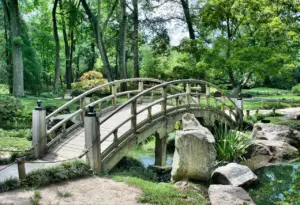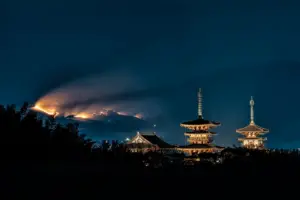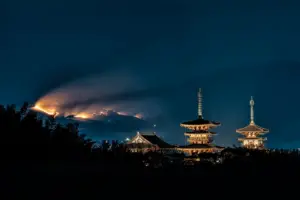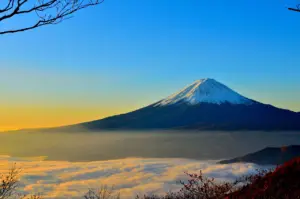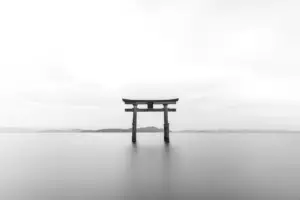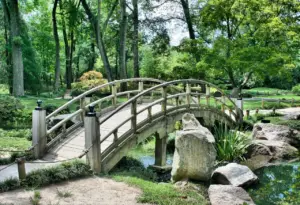Are you tired of the usual tourist spots in Nara? Do you want to explore the city’s hidden gems? Look no further because we’ve got you covered!
In this article, we’ll take you on a journey off the beaten path and show you 7 hidden gems in Nara that are waiting to be discovered.
First up on our list is the Hasedera Temple. This temple is not as well-known as the Todai-ji or Kofuku-ji temples, but it has its own charm. With its stunning gardens and impressive statue of the Eleven-Headed Kannon, you’ll be amazed at the beauty of this temple. And that’s just the beginning! Keep reading to discover more hidden gems in Nara.
Key Takeaways
- Nara offers a range of hidden gems often overlooked by tourists, including Hasedera Temple and Kasugayama Primeval Forest.
- Visitors can enjoy a cozy and intimate atmosphere at a quaint coffee shop in the mountains or unwind at Yoshikien Garden.
- Nigatsu-do Hall and Kofuku-ji Temple offer a glimpse into Japan’s rich cultural heritage and awe-inspiring architecture.
- The Bamboo Forest in Takabatake Park provides a peaceful and calming escape from the bustling crowds.
Hasedera Temple
You’ve gotta check out Hasedera Temple – it’s seriously breathtaking! Located in a quiet residential area, this temple is often overlooked by tourists. But once you step inside, you’ll be blown away by its beauty.
The temple is known for its massive wooden statue of Kannon, the goddess of mercy, which stands at a stunning 30 feet tall. The statue itself is a sight to behold, but the intricate carvings surrounding it add even more to the experience.
As you wander through the temple grounds, you’ll also come across a tranquil garden filled with cherry blossom trees, a pond, and even a small waterfall. The garden is the perfect place to relax and take in the peaceful surroundings. And if you’re lucky enough to visit during cherry blossom season, you’ll be treated to a breathtaking display of pink flowers.
Hasedera Temple is truly a hidden gem in Nara that shouldn’t be missed.
Kasugayama Primeval Forest
The Kasugayama Primeval Forest offers a breathtaking natural landscape that transports visitors to a serene and untouched world. This forest is located on the eastern slope of Mount Kasuga and is one of the few remaining primeval forests in Japan. The forest is home to a wide variety of flora and fauna, including some endangered species.
As you wander through the forest, you will be surrounded by towering trees, some of which are over 800 years old. The forest is also home to numerous walking trails that lead visitors through the pristine landscape. Along the way, you may stumble upon a hidden waterfall or a pond teeming with fish. The forest is also known for its vibrant autumn colors, which draw visitors from all over Japan. With its tranquil atmosphere and stunning natural beauty, the Kasugayama Primeval Forest is truly a hidden gem that is worth exploring.
| Column 1 | Column 2 | Column 3 | ||
|---|---|---|---|---|
| Towering trees | Hidden waterfalls | Vibrant autumn colors | ||
| Endangered species | Pristine landscape | Serene atmosphere | ||
| Walking trails | Teeming ponds | Natural beauty | Meval Forest offers a variety of activities for nature enthusiasts and adventurers alike. |
Coffee Shop in the Mountains
If you’re craving a warm cup of coffee while you’re up in the mountains, there’s a quaint little coffee shop that’s perfect for you. Nestled among the trees, this hidden gem is a must-visit for coffee lovers.
The shop offers a cozy and intimate atmosphere where you can unwind and enjoy a cup of joe while taking in the beautiful scenery around you. Once you step inside the coffee shop, you’ll be greeted with the aroma of freshly brewed coffee.
The menu offers a variety of coffee options, from classic Americanos to more exotic blends like Ethiopian Yirgacheffe. In addition to coffee, the shop also serves pastries and light snacks to satisfy your cravings.
If you’re lucky, you might even catch a live performance by local musicians while you sip your coffee. Don’t miss out on this hidden gem next time you’re in the mountains!
Yoshikien Garden
As you wander through the streets of Nara, don’t miss the chance to explore the stunning Yoshikien Garden. Tucked away from the bustling crowds, this hidden gem offers a serene escape that will transport you back in time. With its meticulously maintained flora and fauna, Yoshikien Garden is a perfect place to unwind and reconnect with nature.
To fully appreciate the beauty of this garden, take your time to explore the three distinct areas: the pond garden, moss garden, and tea ceremony garden. Each section offers its own unique charm that will leave you in awe. The pond garden boasts a tranquil pond surrounded by towering trees, while the moss garden features a carpet of lush green moss and a small waterfall. Finally, the tea ceremony garden provides an authentic Japanese cultural experience, complete with a traditional tea house and garden. Don’t forget to take in the fragrant aroma of the tea and the peaceful ambiance of the garden.
Nigatsu-do Hall
You’ll be mesmerized by the intricate wooden architecture of Nigatsu-do Hall, located on the east side of Todai-ji Temple. As you approach the hall, you’ll be greeted by a stunning view of the surrounding landscape, with cherry blossom trees in the spring and colorful leaves in the fall.
The hall itself is a masterpiece of construction, with intricate carvings and delicate details that showcase the skill of the craftsmen who built it. Inside, you’ll find a serene atmosphere that is perfect for meditation and contemplation.
The hall is home to several important Buddhist statues, including the Eleven-faced Kannon and the Fudo-myoo, both of which are considered national treasures. As you take in the beauty of the hall, you’ll feel a sense of peace and tranquility that is hard to find in the bustling city.
Nigatsu-do Hall is truly a hidden gem that is worth seeking out during your visit to Nara.
Kofuku-ji Temple
When you enter Kofuku-ji Temple, you’ll be transported to a world of ancient beauty and elegance, with towering pagodas and serene gardens that will take your breath away. This UNESCO World Heritage site is one of the most important temples in Nara, and has a rich history dating back to the 8th century. As you wander through the temple grounds, you’ll come across a myriad of stunning structures, including the five-story pagoda, which stands at a height of 50 meters and is the second tallest wooden pagoda in Japan.
To give you a better idea of the beauty you’ll encounter at Kofuku-ji Temple, let’s take a look at some of the highlights in a table:
| Features | |
|---|---|
| 1. | Five-story pagoda (50m in height) |
| 2. | Three-story pagoda (30m in height) |
| 3. | National Treasure Museum |
| 4. | Central Golden Hall (rebuilt in 2018) |
The National Treasure Museum is a must-visit for history buffs, as it houses a collection of over 10,000 artifacts from the temple’s extensive history. Meanwhile, the Central Golden Hall is a recent addition, having been rebuilt in 2018 after being destroyed in a fire in 1717. The hall is a sight to behold, with intricate carvings and gold leaf accents that shimmer in the sunlight. Kofuku-ji Temple is not to be missed during your visit to Nara, offering a glimpse into Japan’s rich cultural heritage and awe-inspiring architecture.
Bamboo Forest in Takabatake Park
If you’re looking for a peaceful escape from the bustling city, take a stroll through the Bamboo Forest in Takabatake Park. This hidden gem is tucked away from the popular tourist attractions in Nara, but it’s definitely worth a visit.
As you enter the park, you’ll be greeted by towering bamboo stalks that create a serene and calming atmosphere. As you wander through the forest, you’ll notice the sunlight filtering through the leaves and casting shadows on the ground. Take a moment to appreciate the natural beauty around you and breathe in the fresh air.
Here are three things to keep in mind during your visit to the Bamboo Forest in Takabatake Park:
- Wear comfortable shoes as the ground can be uneven and rocky in some areas.
- Bring a camera to capture the picturesque scenery and memories of your visit.
- Visit during the early morning or late afternoon to avoid the crowds and enjoy the peacefulness of the forest.
Overall, the Bamboo Forest in Takabatake Park is a hidden gem that provides a tranquil escape from the busy city. Take a break from sightseeing and immerse yourself in the beauty of nature.
Frequently Asked Questions
What is the history of Hasedera Temple and how did it come to be?
Hasedera Temple is a sacred Buddhist site located in Sakurai, Nara. The temple is believed to have been founded in 686 AD by a monk named Hodo who discovered a small statue of Kannon, the goddess of mercy. The statue was said to have been carved by the famous Buddhist monk, Kukai.
The temple is known for its towering wooden statue of Kannon, which stands at a height of 11 meters and is considered to be one of the largest wooden statues in Japan. Over the years, Hasedera Temple has been destroyed and rebuilt several times due to fires and earthquakes, but it remains a popular destination for visitors seeking a peaceful and spiritual experience in Nara.
Are there any specific hiking trails within the Kasugayama Primeval Forest that are recommended for beginners?
If you’re a beginner looking to hike in the Kasugayama Primeval Forest, there are a few trails that are recommended for you. The Kasugayama Nature Trail is a 1.2 km loop that takes you through the forest and past some of the famous Kasuga-taisha Shrine’s hidden shrines and stone lanterns. The trail is relatively flat and easy to navigate, and there are plenty of signs along the way to guide you.
Another option is the Kasugayama Forest Trail, which is a bit longer at 3.5 km, but still manageable for beginners. This trail takes you deeper into the forest and offers stunning views of the surrounding mountains and valleys.
No matter which trail you choose, make sure to wear appropriate footwear and bring plenty of water and snacks.
What is the name of the coffee shop located in the mountains and what types of drinks do they serve?
If you’re looking for a unique coffee experience, head to the mountains and visit the coffee shop called Cafe Miwa. They serve a variety of drinks, including espresso, drip coffee, and seasonal specials like their popular cherry blossom latte.
The shop is located in a traditional Japanese building with a cozy interior and a beautiful outdoor seating area with stunning views of the surrounding mountains. It’s a hidden gem that’s definitely worth the visit.
Can visitors participate in any hands-on activities at Yoshikien Garden?
Yes, visitors can participate in a variety of hands-on activities at Yoshikien Garden in Nara. The garden offers several workshops and experiences throughout the year. These include traditional Japanese tea ceremonies, flower arrangement classes, and calligraphy sessions. Additionally, visitors can try their hand at making their own Japanese-style incense or painting with natural pigments. These activities provide a unique opportunity to learn more about Japanese culture and customs while enjoying the tranquility of the garden’s beautiful surroundings.
Don’t miss out on the chance to add some creativity and cultural immersion to your visit to Nara at Yoshikien Garden.
How long did it take to construct Nigatsu-do Hall and what materials were used?
To answer your question, the Nigatsu-do Hall in Nara took approximately 11 years to construct during the Nara period (710-794). It was built entirely out of wood, following traditional Japanese architectural techniques.
The hall is a designated national treasure and has been restored several times throughout its history. It’s known for its beautiful veranda, from which visitors can enjoy stunning views of Nara.
So, if you’re interested in witnessing a beautiful example of ancient Japanese architecture, Nigatsu-do Hall is definitely worth a visit during your time in Nara.
Conclusion
Congratulations! You’ve discovered some of Nara’s hidden gems that are off the beaten path.
From the serene beauty of Hasedera Temple to the lush greenery of the Kasugayama Primeval Forest, you’ve experienced the true essence of what Nara has to offer.
But the adventure doesn’t end there.
The cozy coffee shop in the mountains, the tranquil Yoshikien Garden, the breathtaking Nigatsu-do Hall, the majestic Kofuku-ji Temple, and the charming Bamboo Forest in Takabatake Park are all waiting for you to explore.
So, why not take a break from the usual tourist spots and immerse yourself in these hidden gems?
You won’t regret it!













